Topology Optimization and Testing of Connecting Rod Based on Static and Dynamic Analyses
Abstract
1. Introduction
2. Materials and Methodology
2.1. Design and Material Selection
2.1.1. Material Selection
2.1.2. Design of Engine Components
2.1.3. Assembly of Engine Components
2.2. Methodology
3. Computational Analysis
3.1. Static Structural Analysis
3.2. Topology Optimization
- To reduce the mass at least by 3%;
- To reduce the maximum von Mises stress and von Mises strain;
- To define the protected depths at both ends of the connecting rod;
- To maintain major dimensions;
- To obtain a different cross-section than the I-Section;
- To keep the FOS above 2.5;
- To manufacture the component in both additive manufacturing and conventional forging.
3.3. Dynamic Analysis
Motion Loads
4. Results
4.1. Results from Static Structural Analysis
4.2. Results from Motion Loads
- The TO process of the connecting rod showed the possibilities of optimizing similar highly dynamic components.
- An improvement in the existing design was achieved by reducing the mass by 5.66%.
- The static structural results were validated by the dynamic analysis.
- The obtained optimized topology was designed in such a way to make it possible to be produced by both conventional manufacturing methods like forging and additive manufacturing.
- The combination of static structural analysis for the design and rigid body dynamics for the verification of the optimized design can be repeated and applied to similar studies.
5. Conclusions
- The topology of the connecting rod was optimized to 5.66% from 654 g to 618 g.
- The maximum von Mises stress was reduced from 5.8556 × 108 Pa to 5.5006 × 108 Pa during static structural analysis.
- The FOS was maintained above 2.6 during the dynamic analysis of the connecting rod.
Author Contributions
Funding
Institutional Review Board Statement
Informed Consent Statement
Data Availability Statement
Acknowledgments
Conflicts of Interest
Abbreviations
| TO | Topology optimization |
| FOS | Factor of safety |
| FEM | Finite element method |
| RPM | Revolutions per minute |
| CAD | Computer-aided design |
| IC | Internal combustion |
| STEP | Standard for the Exchange of Product |
| SIMP | Solid Isotropic Material with Penalization |
| STL | Stereolithography |
| DOF | Degree of freedom |
| TDC | Top dead center |
| BDC | Bottom dead center |
| DIC | Digital image correlation |
References
- Heywood, J.B. Internal Combustion Engine Fundamentals; McGraw-Hill: New York, NY, USA, 1988. [Google Scholar]
- J604D_197906; Engine Terminology and Nomenclature-General. SAE: Warrendale, PA, USA, 1979.
- Kocaaslan, O. Numerical investigation on pulse detonation engine performance under different equivalence ratio. Adv. Eng. Lett. 2024, 3, 1–12. [Google Scholar] [CrossRef]
- Decker, Ž.; Rudzinskas, V.; Drozd, K.; Caban, J.; Tretjakovas, J.; Nieoczym, A.; Matijošius, J. Analysis of the Vehicle Chassis Axle Fractures. Materials 2023, 16, 806. [Google Scholar] [CrossRef] [PubMed]
- Camba, J.D.; Contero, M.; Company, P. Parametric CAD Modeling: An Analysis of Strategies for Design Reusability. Comput.-Aided Des. 2016, 74, 18–31. [Google Scholar] [CrossRef]
- Rao, S.S. The Finite Element Method in Engineering; Butterworth-Heinemann: Oxford, UK, 2017. [Google Scholar]
- Gao, W.; Wang, G.; Zhu, J.; Fan, Z.; Li, X.; Wu, W. Structural Optimization Design and Strength Test Research of Connecting Rod Assembly of High-Power Low-Speed Diesel Engine. Machines 2022, 10, 815. [Google Scholar] [CrossRef]
- Shabana, A.A. Dynamics of Multibody Systems; Cambridge University Press: Cambridge, UK, 2013; ISBN 9781107042650. [Google Scholar]
- Caban, J.; Nieoczym, A.; Matijošius, J.; Kilikevičius, A.; Drozd, K. Analysis of the construction of the car trailer frame in terms of changing the assembly technology. Sci. J. Silesian Univ. Technol. Ser. Transp. 2024, 124, 47–61. [Google Scholar] [CrossRef]
- Wang, R.; Zhang, X.; Zhu, B.; Zhang, H.; Chen, B.; Wang, H. Topology Optimization of a Cable-Driven Soft Robotic Gripper. Struct. Multidiscip. Optim. 2020, 62, 2749–2763. [Google Scholar] [CrossRef]
- Okorie, O.; Perveen, A.; Talamona, D.; Kostas, K. Topology Optimization of an Aerospace Bracket: Numerical and Experimental Investigation. Appl. Sci. 2023, 13, 13218. [Google Scholar] [CrossRef]
- Mirzendehdel, A.M.; Behandish, M.; Nelaturi, S. Topology Optimization with Accessibility Constraint for Multi-Axis Machining. Comput.-Aided Des. 2020, 122, 102825. [Google Scholar] [CrossRef]
- Bendsøe, M.P.; Sigmund, O. Topology Optimization: Theory, Methods and Applications; Springer: Berlin/Heidelberg, Germany, 2004; ISBN 978-3-662-05086-6. [Google Scholar]
- Mikulikova, A.; Mesicek, J.; Karger, J.; Hajnys, J.; Ma, Q.-P.; Sliva, A.; Smiraus, J.; Srnicek, D.; Cienciala, S.; Pagac, M. Topology Optimization of the Clutch Lever Manufactured by Additive Manufacturing. Materials 2023, 16, 3510. [Google Scholar] [CrossRef] [PubMed]
- Richard van Basshuysen, F.S. Internal Combustion Engine Handbook: R-345: Basics, Components, Systems and Perspectives; SAE International: Warrendale, PA, USA, 2004. [Google Scholar]
- Kou, S.; Shi, Z.; Song, W. Fracture-Splitting Processing Performance Study and Comparison of the C70S6 and 36MnVS4 Connecting Rods. SAE Int. J. Engines 2018, 11, 463–474. [Google Scholar] [CrossRef]
- Yan, J.; Chen, L.; Zhang, C.; Miao, H.; Wang, S.; Wu, G.; Gao, J.; Wu, H.; Zhao, H. Influence of Sulfur on the Splitting Fracture and Machining Performance of Microalloyed Medium-Carbon Steel 36MnVS4 Connecting Rods. J. Mater. Eng. Perform. 2024, 33, 12125–12132. [Google Scholar] [CrossRef]
- Shaari, M.S.; Rahman, M.M.; Noor, M.M.; Kadirgama, K.; Amirruddin, A.K. Design of Connecting Rod of Internal Combustion Engine: A Topology Optimization Approach. In Proceedings of the National Conference in Mechanical Engineering Research and Postgraduate Studies, Kuantan, Pahang, Malaysia, 3–4 December 2010; pp. 155–166. [Google Scholar]
- Hamm, T.; Rebbert, M.; Ecker, H.-J.; Grafen, M. Cylinder Head Design for High Peak Firing Pressures. SAE Int. J. Engines 2008, 1, 746–755. [Google Scholar] [CrossRef]
- Bendsøe, M.P.; Kikuchi, N. Generating Optimal Topologies in Structural Design Using a Homogenization Method. Comput. Methods Appl. Mech. Eng. 1988, 71, 197–224. [Google Scholar] [CrossRef]
- Topology Optimization. Available online: https://ansyshelp.ansys.com/public/account/secured?returnurl=/Views/Secured/corp/v242/en/discovery/UDA/user_manual/physics/structural/topics/c_topo_intro.html (accessed on 3 October 2024).
- User Guide, Altair OptiStruct. Available online: https://2021.help.altair.com/2021/hwsolvers/os/topics/solvers/os/topology_opt_design_variables_r.htm (accessed on 10 October 2024).
- Setting the Protected Depth. Available online: https://ansyshelp.ansys.com/public/account/secured?returnurl=//////Views/Secured/corp/v242/en/discovery/UDA/user_manual/physics/structural/topics/t_topo_protect_distance.html (accessed on 24 September 2024).
- Topology Optimization Goals and Tool Options. Available online: https://ansyshelp.ansys.com/public/account/secured?returnurl=//////Views/Secured/corp/v242/en/discovery/UDA/user_manual/physics/structural/topics/r_structural_topo_tools.html (accessed on 12 September 2024).
- Creating the SubD Hybrid Model. Available online: https://ansyshelp.ansys.com/public/account/secured?returnurl=/Views/Secured/corp/v242/en/discovery/UDA/user_manual/modeling/facets/topics/t_autoskin_create_subd_hybrid.html?q=subD%20hybrid (accessed on 12 October 2024).
- Duysinx, P.; Bendsøe, M.P. Topology Optimization of Continuum Structures with Local Stress Constraints. Int. J. Numer. Methods Eng. 1998, 43, 1453–1478. [Google Scholar] [CrossRef]
- Senhora, F.V.; Giraldo-Londoño, O.; Menezes, I.F.M.; Paulino, G.H. Topology Optimization with Local Stress Constraints: A Stress Aggregation-Free Approach. Struct. Multidiscip. Optim. 2020, 62, 1639–1668. [Google Scholar] [CrossRef]
- Shigley, J.E.; Mischke, C.R. Standard Handbook of Machine Design; McGraw-Hil: New York, NY, USA, 1986. [Google Scholar]
- Xu, L.; Li, Q.; Zhang, N.; Chen, Q. Mobility, Kinematic Analysis, and Dimensional Optimization of New Three-Degrees-of-Freedom Parallel Manipulator With Actuation Redundancy. J. Mech. Robot. 2017, 9, 041008. [Google Scholar] [CrossRef]
- Rice, R.C. SAE Fatigue Design Handbook AE-22; SAE International: Warrendale, PA, USA, 1997. [Google Scholar]
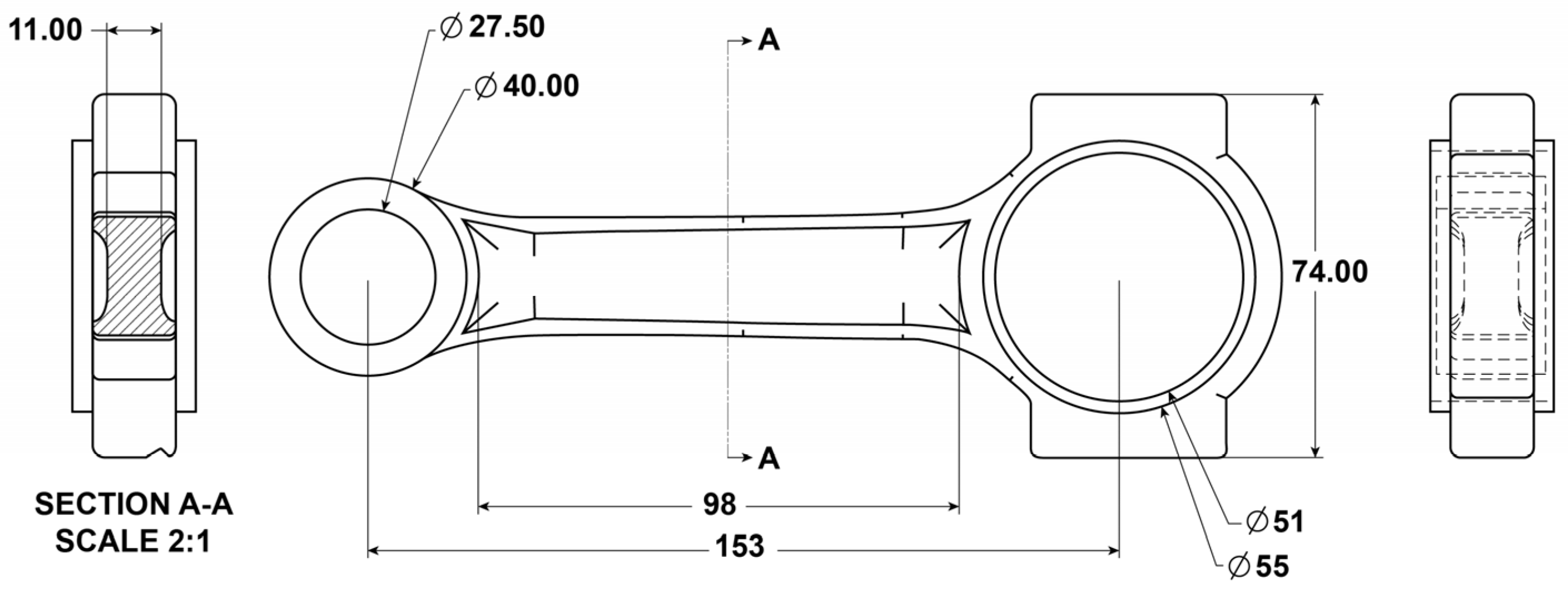
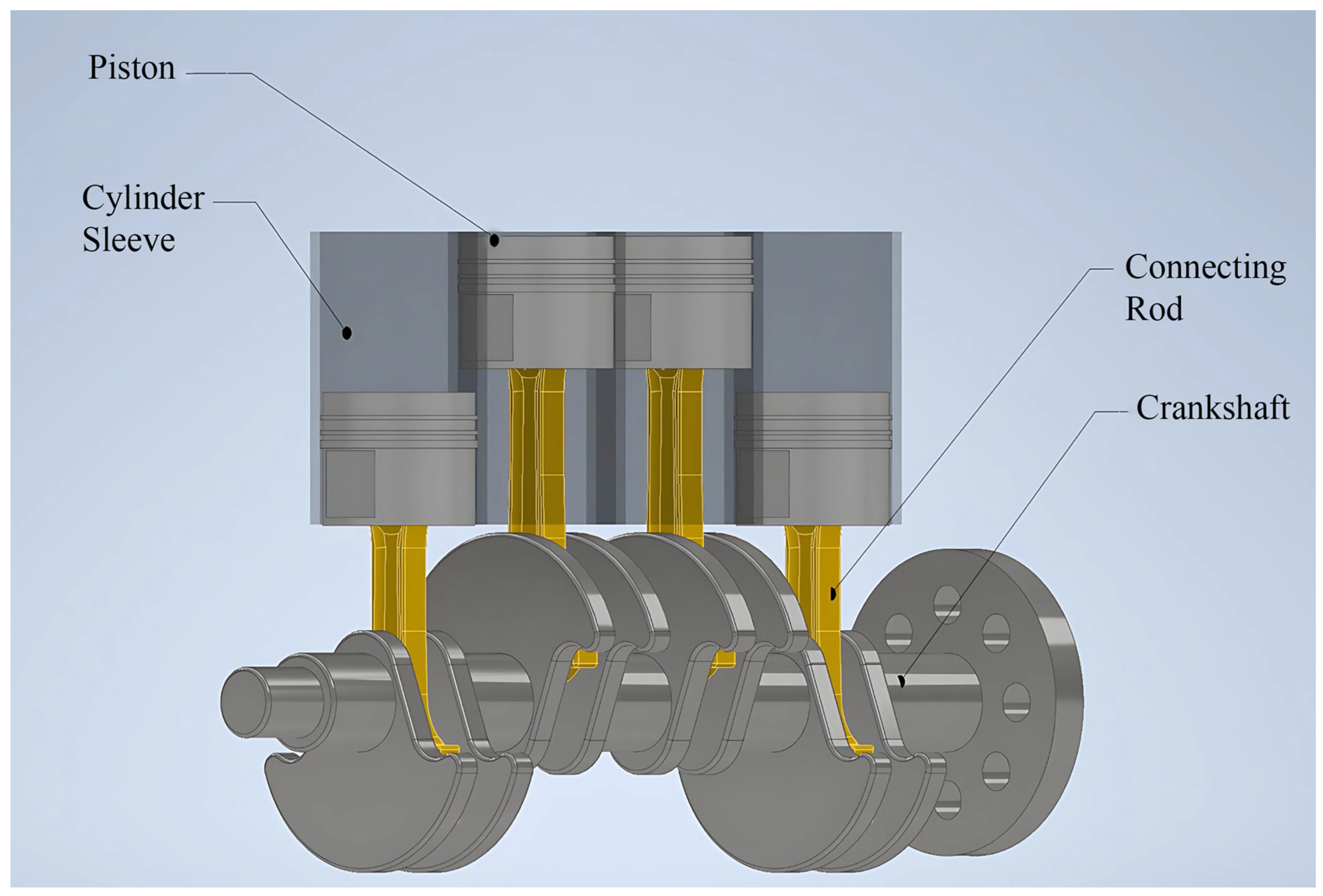
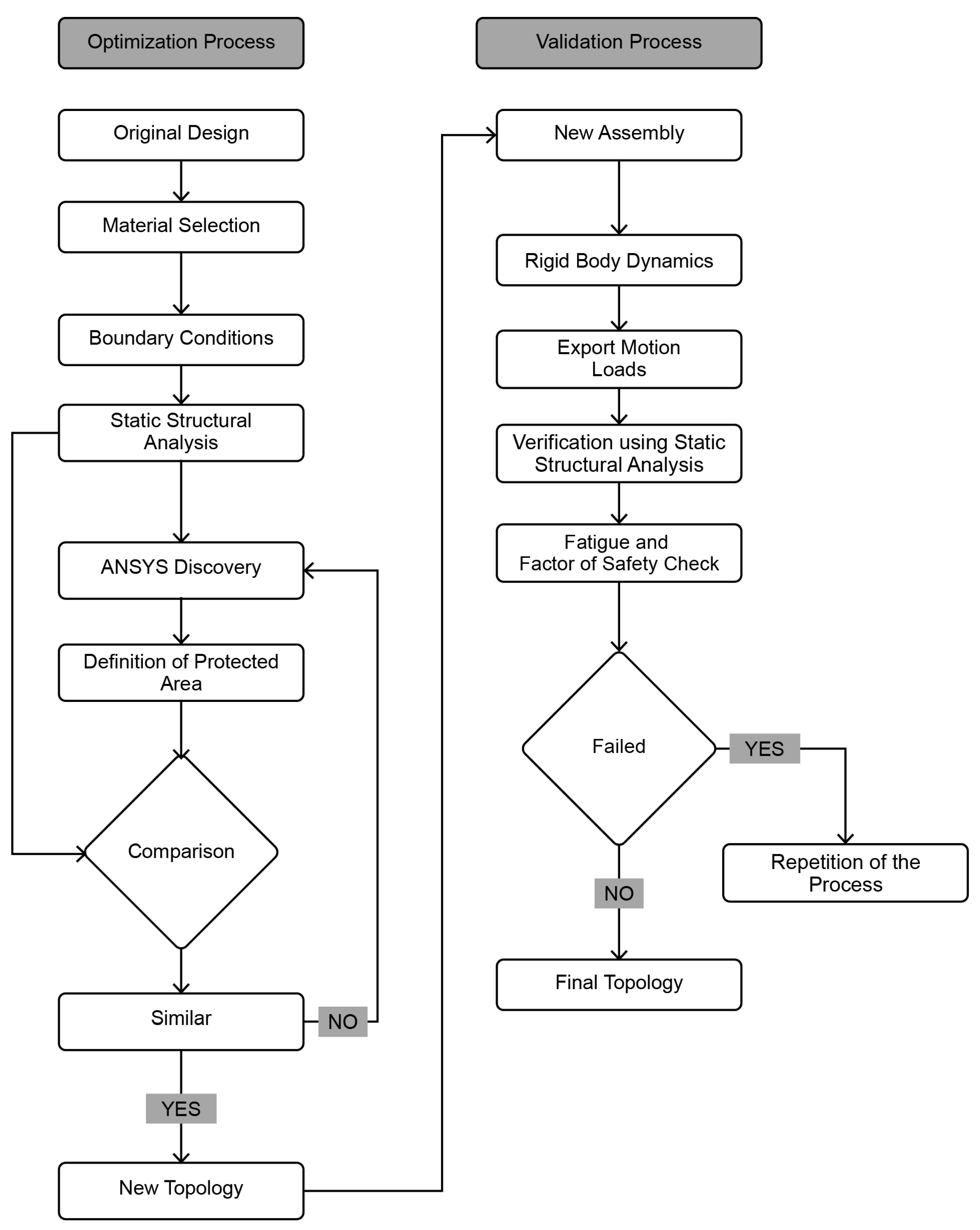
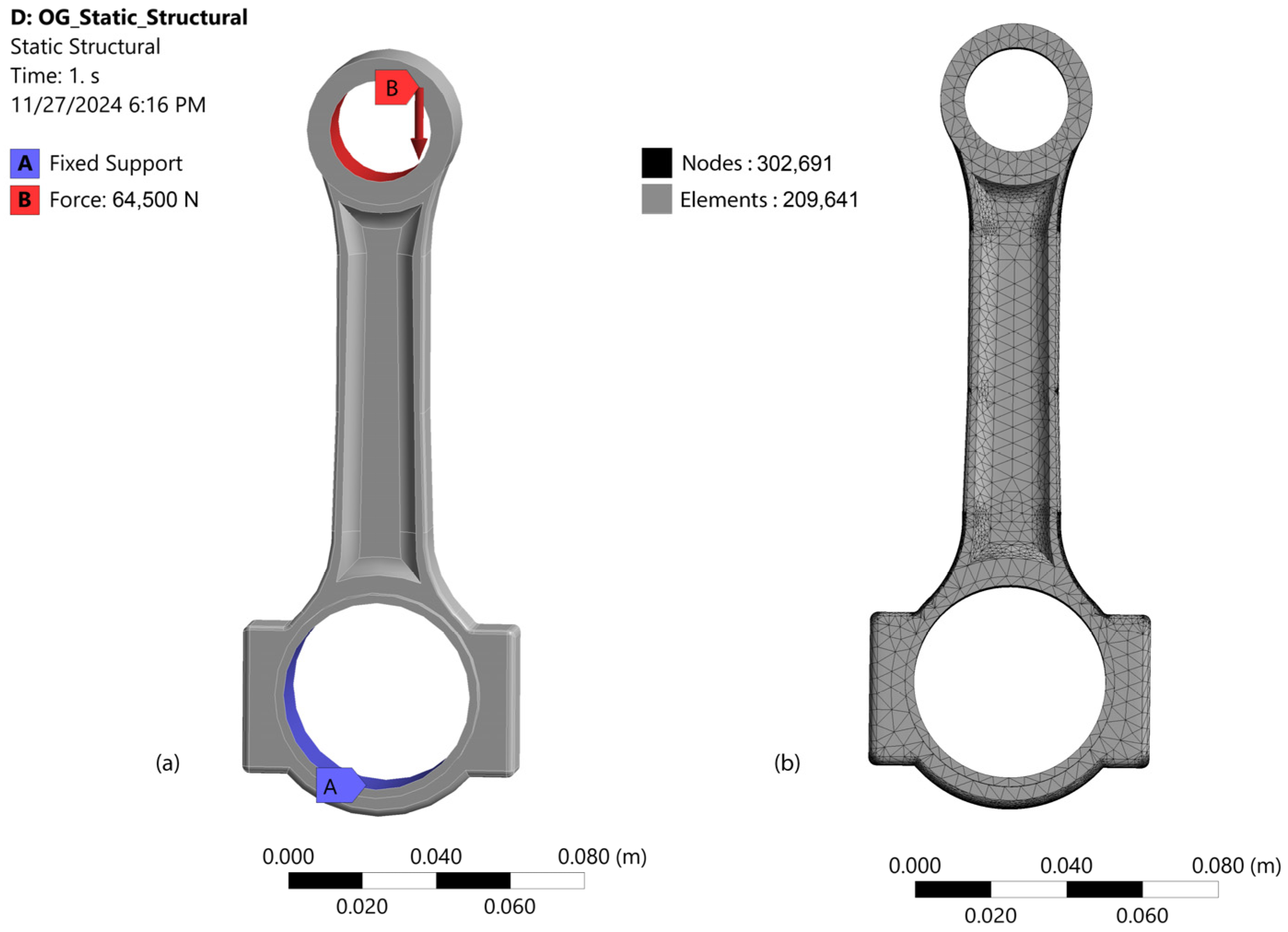
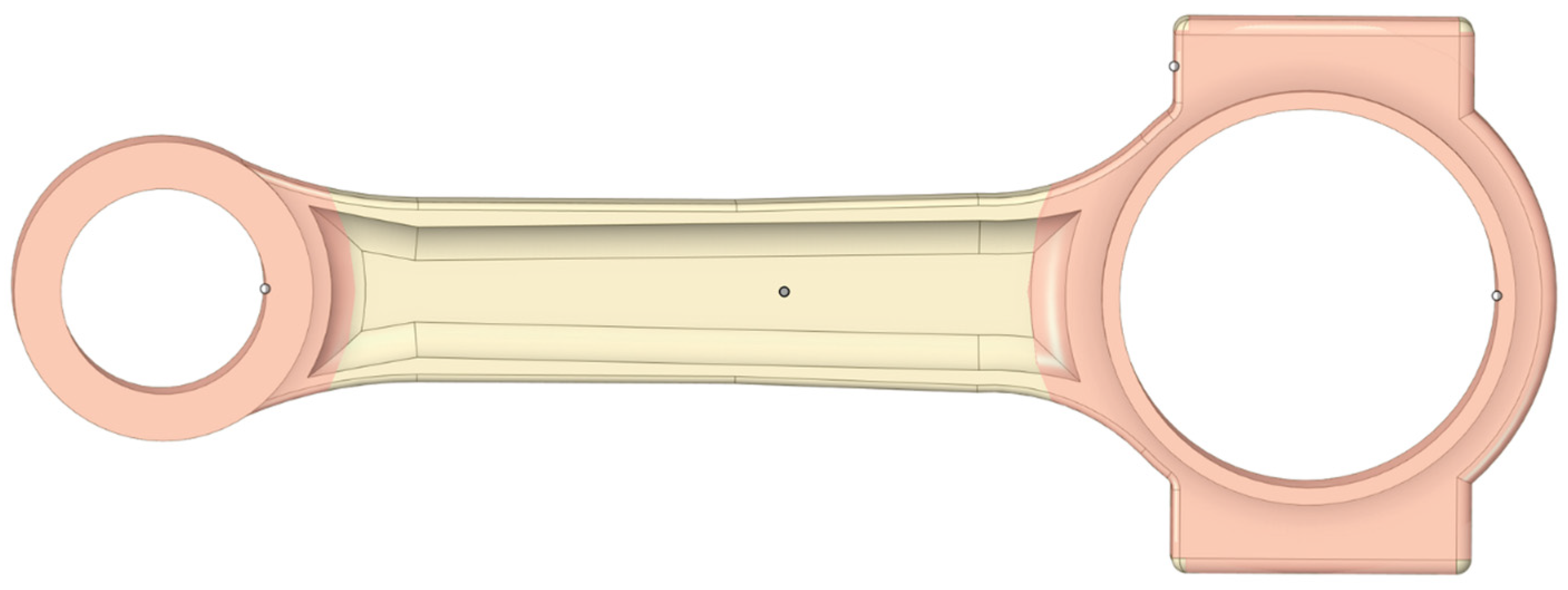
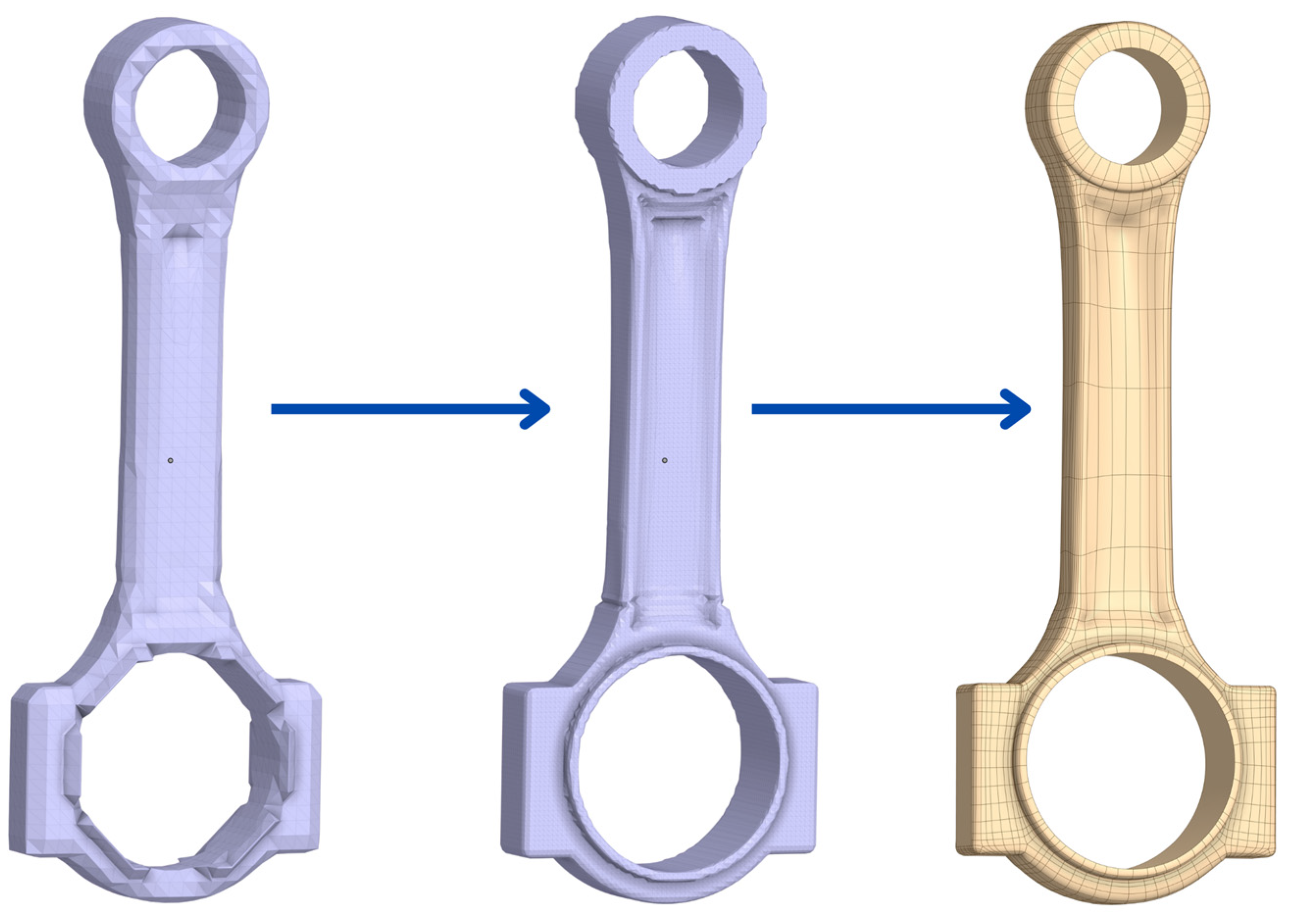

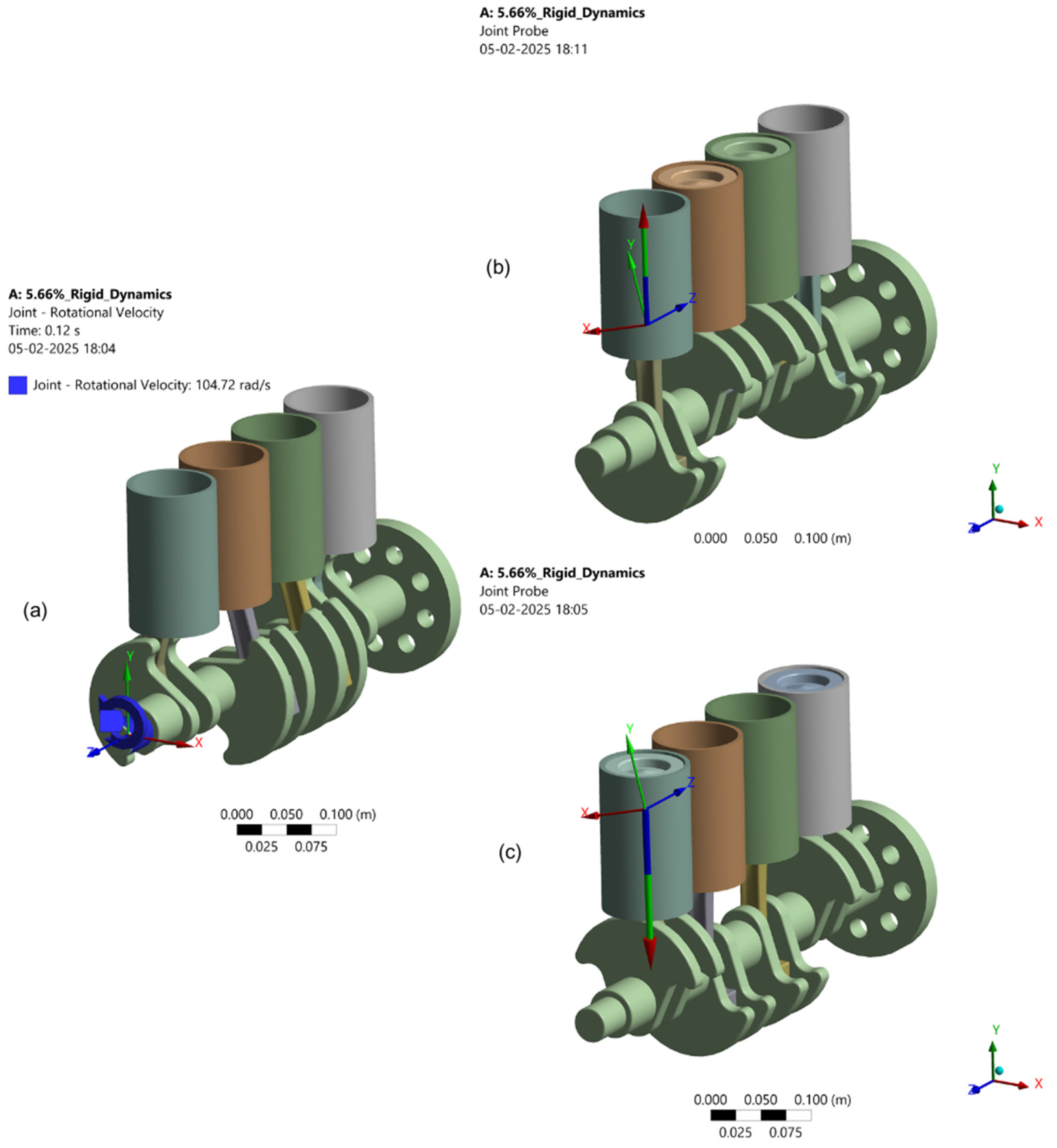
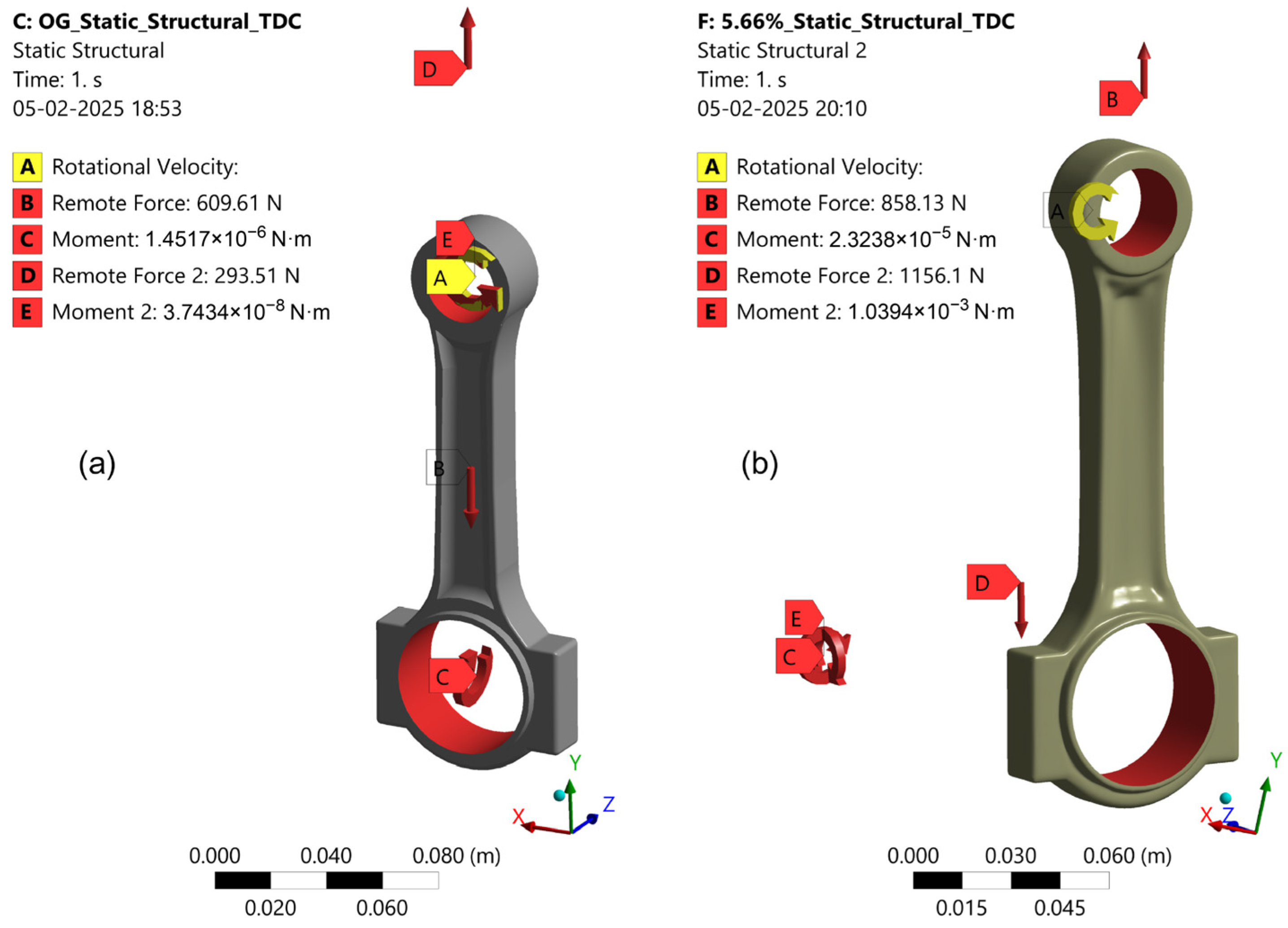
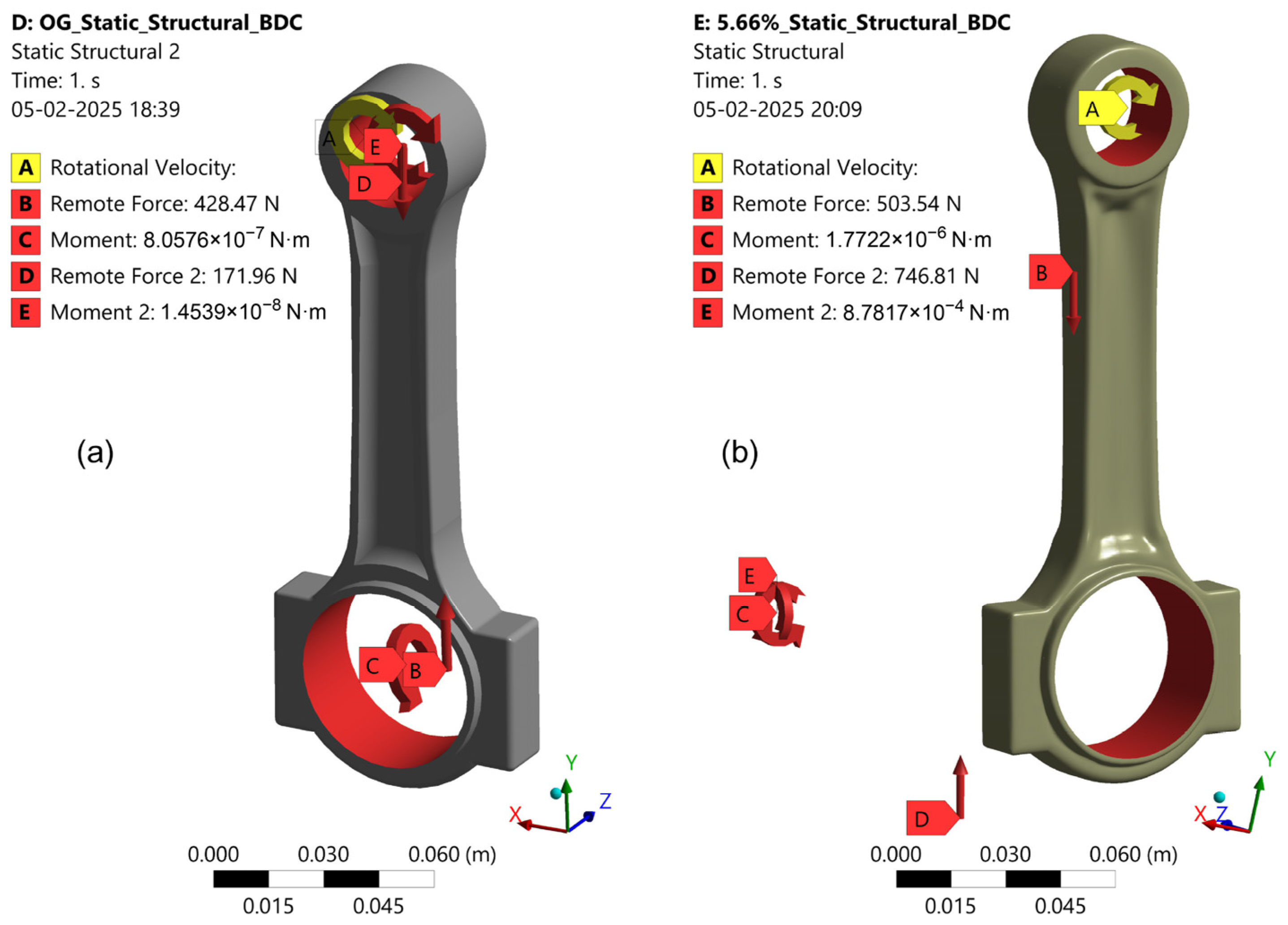
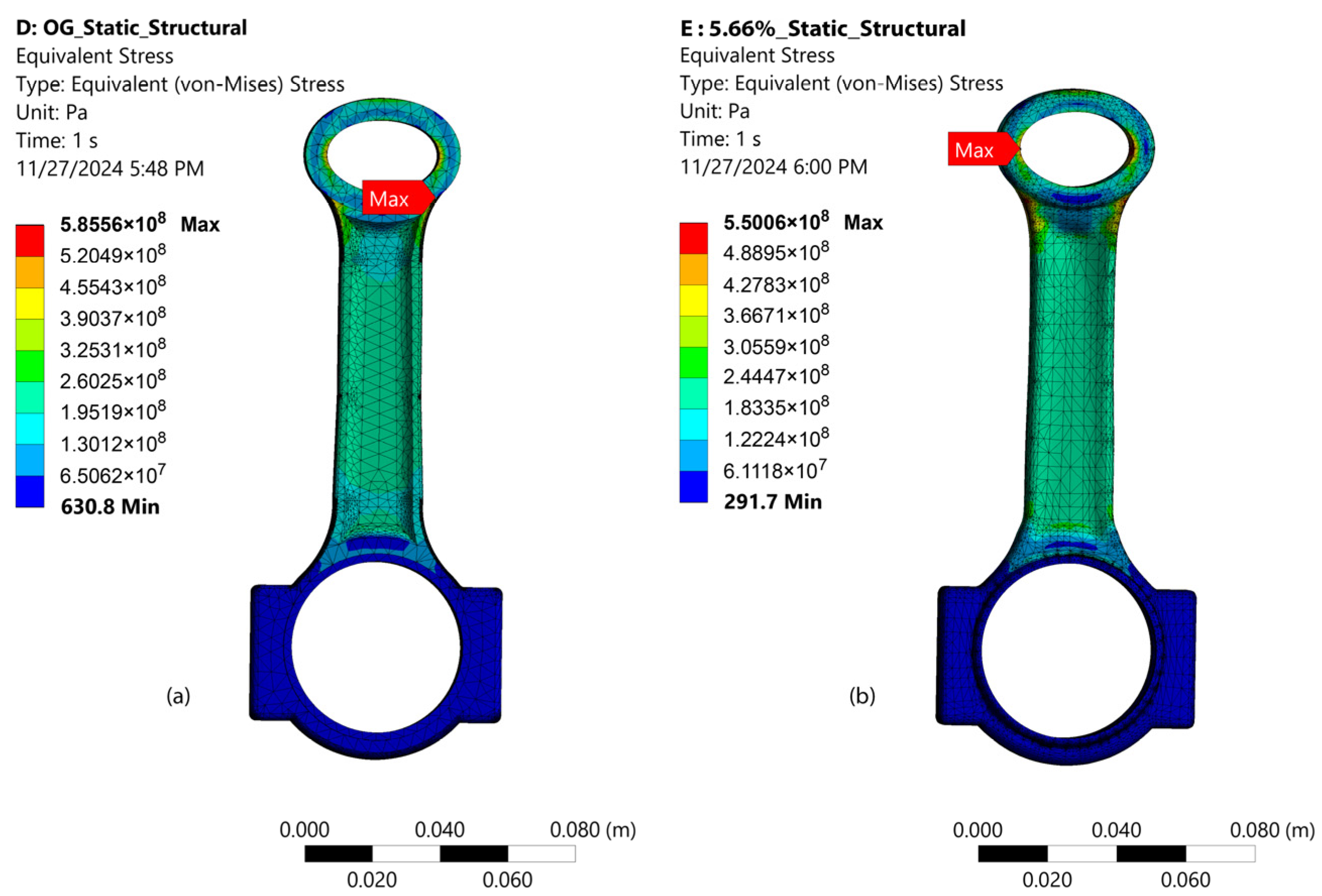
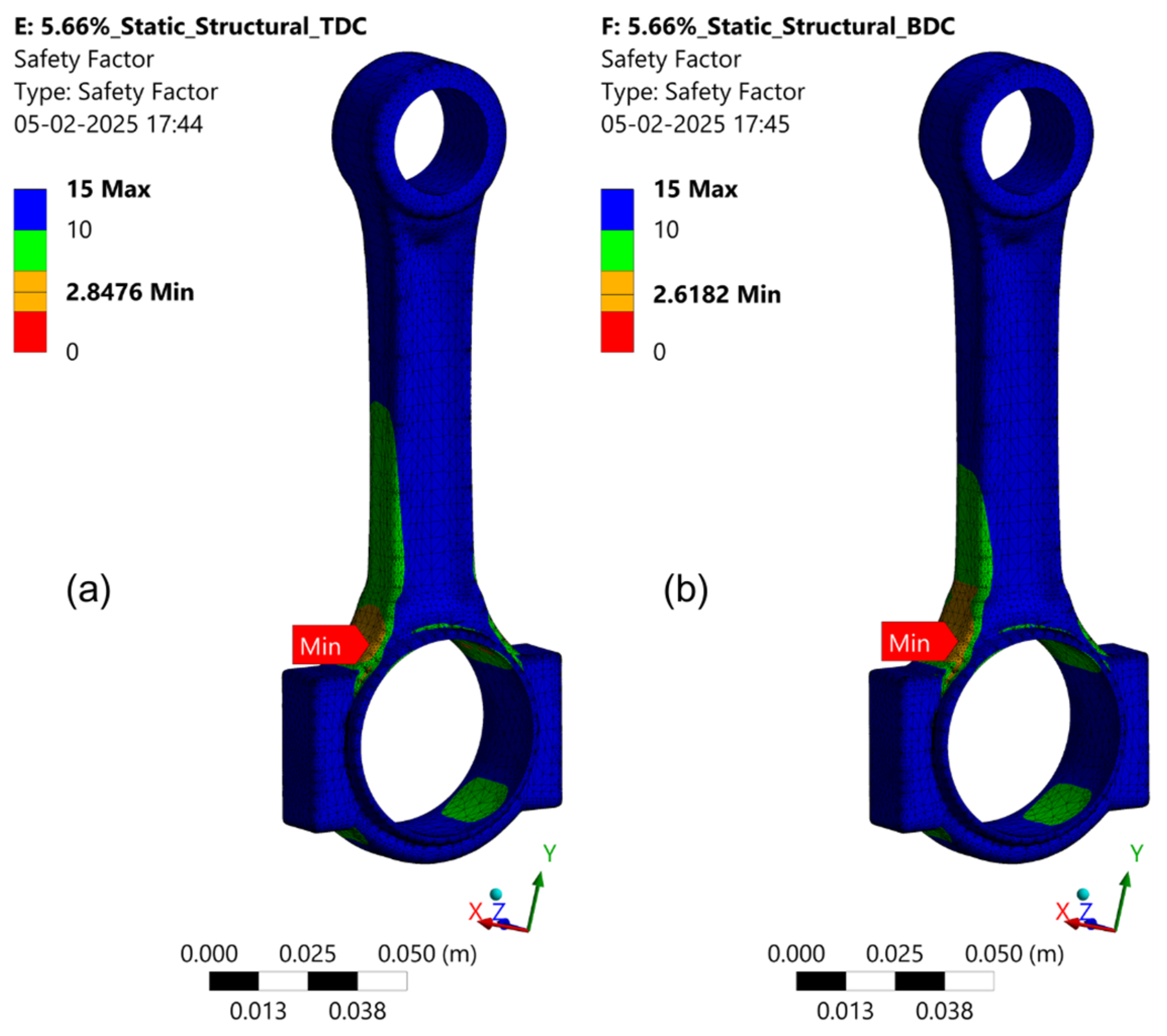
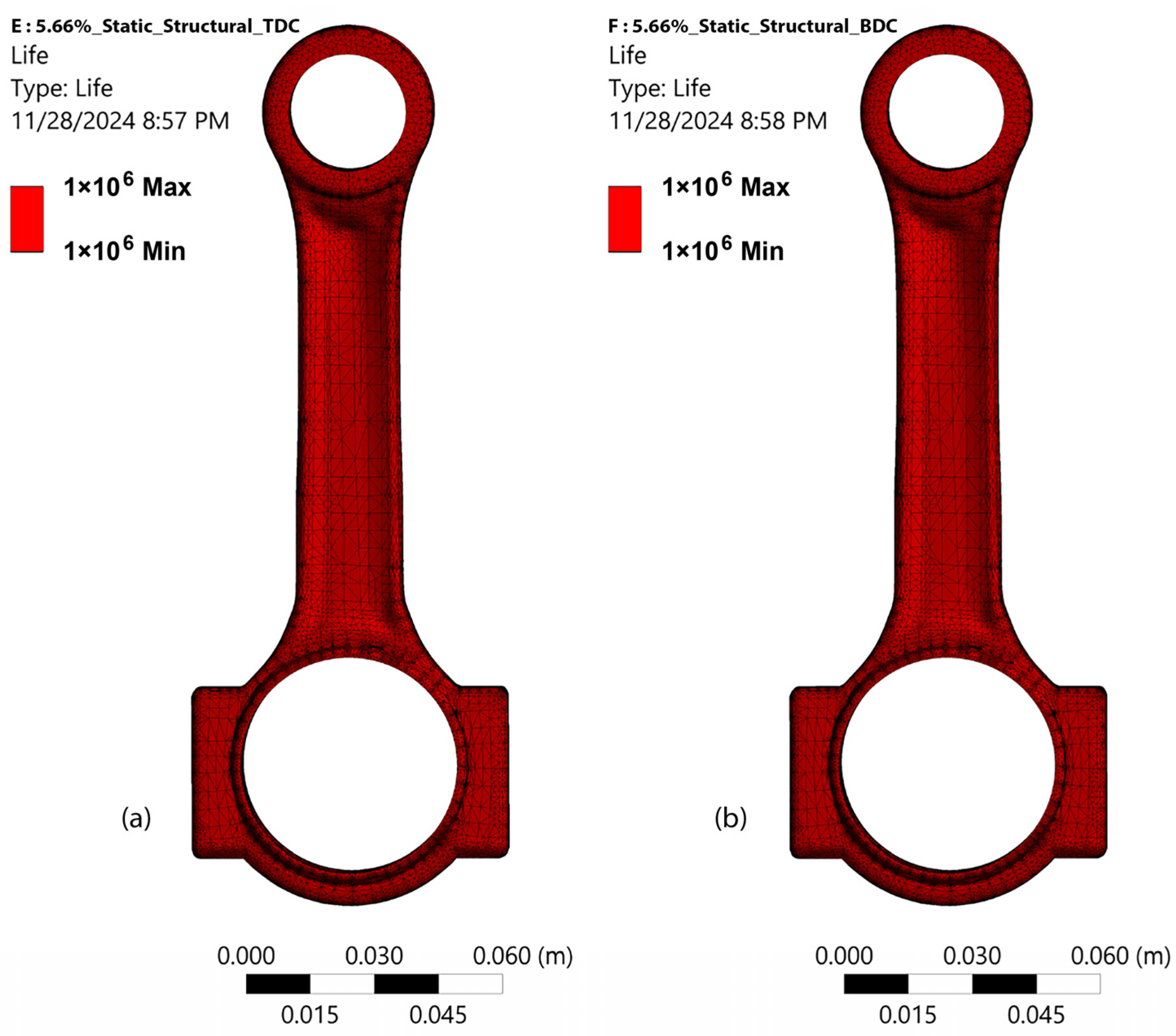
| Yield Strength | Tensile Strength | Density | Modulus of Elasticity | Poisson’s Ratio |
|---|---|---|---|---|
| 800 MPa | 1000 MPa | 7.85 g/cm3 | 210 GPa | 0.29 |
| Engine Type | Cylinder Bore | Stroke Length | Engine Speed |
|---|---|---|---|
| Inline 4-cylinder | 81 mm | 82.25 mm | 1000 rpm (Max) |
| Connections Between the Parts | Joints Used | Degrees of Freedom |
|---|---|---|
| Cylinder liners to ground | Fixed joint | 0 DOF |
| Crankshaft to ground | Fixed revolute joint | 1 DOF |
| Cylinder to piston | Transitional joint | 4 (x-axis) |
| Piston to connecting rod | Revolute joint | 4 DOFs |
| Connecting rod to crankshaft | Revolute joint | 4 DOFs |
Disclaimer/Publisher’s Note: The statements, opinions and data contained in all publications are solely those of the individual author(s) and contributor(s) and not of MDPI and/or the editor(s). MDPI and/or the editor(s) disclaim responsibility for any injury to people or property resulting from any ideas, methods, instructions or products referred to in the content. |
© 2025 by the authors. Licensee MDPI, Basel, Switzerland. This article is an open access article distributed under the terms and conditions of the Creative Commons Attribution (CC BY) license (https://creativecommons.org/licenses/by/4.0/).
Share and Cite
Nainaragaram Ramasamy, M.; Slíva, A.; Govindaraj, P.; Nag, A. Topology Optimization and Testing of Connecting Rod Based on Static and Dynamic Analyses. Appl. Sci. 2025, 15, 2081. https://doi.org/10.3390/app15042081
Nainaragaram Ramasamy M, Slíva A, Govindaraj P, Nag A. Topology Optimization and Testing of Connecting Rod Based on Static and Dynamic Analyses. Applied Sciences. 2025; 15(4):2081. https://doi.org/10.3390/app15042081
Chicago/Turabian StyleNainaragaram Ramasamy, Mahalingam, Aleš Slíva, Prasath Govindaraj, and Akash Nag. 2025. "Topology Optimization and Testing of Connecting Rod Based on Static and Dynamic Analyses" Applied Sciences 15, no. 4: 2081. https://doi.org/10.3390/app15042081
APA StyleNainaragaram Ramasamy, M., Slíva, A., Govindaraj, P., & Nag, A. (2025). Topology Optimization and Testing of Connecting Rod Based on Static and Dynamic Analyses. Applied Sciences, 15(4), 2081. https://doi.org/10.3390/app15042081









